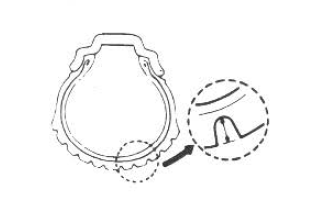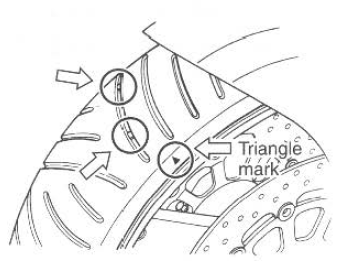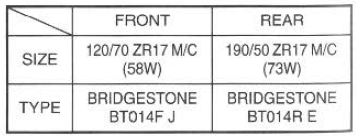Suzuki GSX-R 1000 Owners Manual: Tire condition and type
Tire condition and tire type affect motorcycle performance. Cuts or cracks in the tires can lead to tire failure and loss of motorcycle control. Worn tires are susceptible to puncture failures and subsequent loss of motorcycle control.
Tire wear also affects the tire profile, changing motorcycle handling characteristics.

Check tire conditions each day before you ride. Replace tires if tires show visual evidence of damage, such as cracks or cuts, or if tread depth is less than 1.6 Mm (0.06 In) front, 2.0 Mm (0.08 In) rear.

Note
: the ''triangle mark" indicates the place where the wear bars are molded into the tire.
When the wear bars contact the road, it indicates that the tire wear limit has been reached. Whenever you replace a tire, use a tire of the size and type listed below. If you use a different size or type of tire, motorcycle handling may be adversely affected, possibly resulting in loss of motorcycle control.

Always balance the wheel after repairing a puncture or replacing the tire. Proper wheel balance is important to avoid variable wheelto- road contact, and to avoid uneven tire wear.
 Warning Warning
|
 Warning Warning
|
 Tire pressure and loading
Tire pressure and loading
Proper tire pressure and proper
tire loading are important factors.
Overloading your tires can lead to
tire failure and loss of vehicle control.
Check tire pressure each day
before you ride, ...
 Side standngnition interlock switch
Side standngnition interlock switch
Check the side stand/ignition
interlock system for proper operation
as follows:
Sit on the motorcycle in the
normal riding position, with the
side stand up.
Shift into firs ...
Other materials:
Fuel discharge amount inspection
Keep away from fire or spark.
Spilled gasoline should be wiped off
immediately.
Work in a well-ventilated area.
Inspect the fuel discharge amount in the following
procedures:
lift and support the fuel tank. Refer to “fuel tank remo ...
Spark plug inspection and cleaning
Inspect spark plug
every 6 000 km (4 000 miles, 12 months)
Heat range
Remove the spark plugs. Refer to “ignition coil and spark plug removal
and installation” in section 1h .
Check spark plug heat range by observing electrode
color. If the electrode of the spark plug is wet
appe ...
Precautions
Precautions for driveline / axle
Refer to “general precautions” in section 00 (page 00-1).
Never inspect or
adjust the drive chain while the engine is running.
Caution
do not use trichloroethylene, gasoline or such similar
solvent. These fluids will d ...
